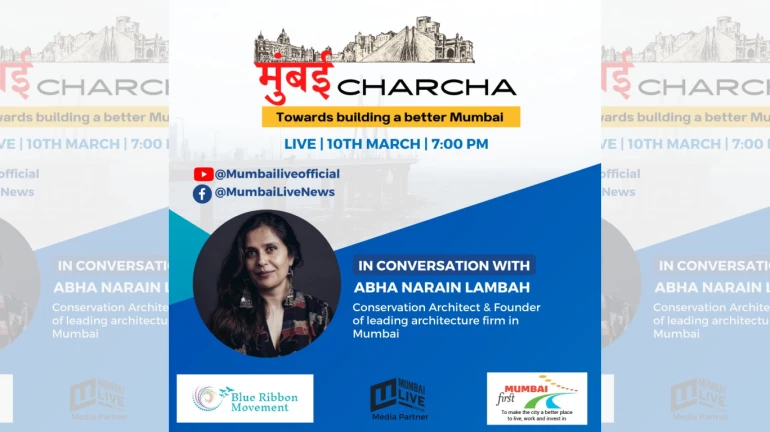
Abha Narain Lambah is a practicing Conservation Architect and a recipient of the Eisenhower Fellowship (USA) 2002, the Charles Wallace Fellowship (U.K.) 1998, the Attingham Trust Fellowship 2007, the Sankriti Award 2003, Architect of the Year Award 2019 Architectural Digest and Architect of the Year Award CNBC Awaaz 2017.
An advocate for Mumbai’s heritage, Abha has, in the past 25 years, done pioneering work on urban guidelines for heritage precincts such as Banganga, Khotachiwadi, Dadabhai Naoroji Road and has prepared the successful nomination inscribing Mumbai’s Art Deco & Victorian ensemble as a UNESCO World Heritage Site. She has spearheaded the restoration of 19th century landmarks such as Mumbai University’s Convocation Hall, Elphinstone College, Sir JJ School of Art, Tata Palace (Deutche Bank), Municipal Head Office, Asiatic Library, High Court, Old Secretariat and Crawford Market. She has advised on museum design for Indian Museum Kolkata and Rashtapati Bhavan Museum Delhi, Prince of Wales and Mani Bhavan Mumbai, Bharatpur and Bangalore State Museums, Chowmahalla Palace Hyderbad, Swaraj Bhavan and Anand Bhavan Allahabad and is currently working on the Nehru Memorial Library & Museum, Balasaheb Thackeray National Memorial and the Lal Bagh Palace Museum in Indore for World Monuments Fund.
Abha Narain Lambah Associates is the largest architectural conservation consultancy in India and has won 10 UNESCO Asia Pacific Awards for Heritage Conservation.
Here are the excerpts from her chat in Mumbai Charcha:
How is your relationship with the Mumbai as you are the one who engages deeply with things that are distinctly Mumbai?
Mumbai is my “karmbhoomi”. However, I have longest lived in Mumbai than any other city, for nearly 27 years now and I am a very proud Mumbaikar. It is like an adrenaline rush. Once you have been located here, it is difficult to live or love any other city.
How much do you rate Mumbai in terms of its capacity to preserve the heritage compared to European Cities?
In my opinion, comparing Mumbai with European city is unfair, due to funding, resources provided by their government is different. Europe had long ago learnt and stopped treating heritage site as liability but asset.
Talking about Mumbai, despite being business destination, we haven’t been able to package our cultural sites and historic buildings. Maharashtra has the potential to be a leader in number of world heritage, we do not perceive it as cultural destination. Until 1995, there were zero protection sites registered under Archaeological Survey of India (ASI). Later, Mumbai became the first city in India to establish heritage regulations for Greater Mumbai. And, 632 sites were recognized by the citizens as worthy of protection. With this, Mumbai is trailblazer in defining cultural heritage and challenging the concept of reservation.
What led Mumbai to be a path breaker?
There were several citizens and some great people like Author Shyam Chainani, Former Municipal Commissioner Jamsheed Kanga, who believed that city deserves to have heritage and culture sites. Along with the then Chief Minister Sharad Pawar, these people came together as they had empathy for heritage as the Centre would not take the then Bombay and heritage hand in hand. Mumbaikars have intimate relationships with every building, which at some point of time is or will become an old or heritage buildings.
Besides, they have a sense of passion and great belonging for the city is unprecendented.
Can you elaborate on resources provided for this work?
Maharashtra government is the most proactive than any other state. In 2007-2008, they put specific clause and feed fund for buildings owned by the government such PWD Buildings, Asiatic library and various other landmark buildings, are funded by them. similarly, there should be a corpus or strategy for incentivizing the heritage that falls in the realm of public and private trust ownership. CSR also recognizes conservation of heritage.
What is your vision for Mumbai?
Mumbai should embrace its uniqueness rather than trying to be a shangai. It should realise its specialty, which combination of everything and is surrounded by sea, historic monument, nation park. Besides, it also a safest city for women. People should work hard to keep up with its reputation.
Every Mumbaikar should ask themselves - How can I make this city better?
Moreover, people should work for better public toilets for men and women. Besides, they should work to improve in making things already available in this generous city.





